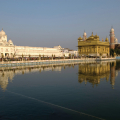The most sacred Sikh place of worship in India, with a marble and gold setting and a pool built in honour of Guru Granth Sahib
Sri Harmandir Sahib, more commonly known as the Golden Temple, is the holiest Sikh place of worship in India, a marble and gold jewel box built for Guru Granth Sahib. Enter through the main gate: the Clock Tower; go down a few steps and open your eyes: in the middle of the sacred basin, 5 m deep, stands the superb Golden Temple. Majestic building of white marble inlaid with precious and semi-precious stones, topped by a dome of more than 600 kg of gold, in the shape of an inverted lotus flower. The Sikh community in Birmingham regularly contributes to replace the gold leaves. The lotus flower symbolizes the Sikhs' rule of conduct: to lead a pure life. The architecture of this building blends Mughal and Rajput influences. If you can, go there once at night and return the next day during the day.
Take the Parikrama - the white marble walkway around the temple - and walk on the mats if you don't want to burn the soles of your feet. Photos are only allowed around the pool. Inside the shrine are massive guards dressed in orange uniforms and armed with spears. Families sleep, eat or drink in the shade. Pilgrims, tourists and the curious are lounging, lulled by the reading of the holy book Granth Sahib and the hypnotic chants. Men bathe, keeping only their turban and their underpants in which they wedge their dagger. A weapon that Sikh women also carry on their salwar-kameez. After the ablutions, the faithful gather in the temple.
To enter, one must cross the Guru's Bridge. The temple houses the object of all veneration and attention: the original copy of the Granth Sahib, covered with pink silk, kept on the second floor. Priests take turns to sing its praises in music.
Crowds flock there at all hours of the day and especially on weekends (about 100,000 people per day). When evening comes, the show is sumptuous: the lights are reflected in the gold of the temple and the water of the basin.
At 10 pm, the religious fervor is at its peak: the sacred book is brought back to the Akal Takhat, the Sikh parliament building, for the night. It will remain there until 4 am in summer and 5 am in winter. During the day, it is kept in the Hari Mandir Sahib under a veil. At the time of his transfer, a priest loads the canopy on his head and crosses the bridge in the middle of the crowd. Clamor and songs accompany him. The same ritual takes place in the morning.
The temple also contains a small museum, the Central Sikh Museum (open every day from 7 am to 7 pm.) The portraits of the different Sikh martyrs over the centuries are exhibited. It contains many relics tracing the history of the gurus. A bit boring.
If you are a little hungry, take your place in line for the Guru Ka Langar, the communal dining hall (see "Restaurants"). Here, a free meal is served to all, regardless of class or religion, prepared by the Sikh faithful.
It is said that the temple never sleeps, but go and have a look in the gurudwara of the temple which welcomes pilgrims for the night. A real city within a city, the temple also has a library, a bank, a tourist office and a train ticket booking office.
Did you know? This review was written by our professional authors.
Book the Best Activities with Get Your Guide
Members' reviews on GOLDEN TEMPLE
The ratings and reviews below reflect the subjective opinions of members and not the opinion of The Little Witty.


Upon stepping into the complex, visitors are greeted by the breathtaking sight of the shimmering golden structure, beautifully reflecting in the Amrit Sarovar (Pool of Nectar) that surrounds it. The Golden Temple's architecture is a blend of Islamic and Hindu styles, showcasing exquisite craftsmanship and attention to detail.
One cannot help but be overwhelmed by the serene and mystical energy that pervades the atmosphere here. Whether you're a devotee seeking spiritual solace or a traveler exploring the rich cultural heritage of India, the Golden Temple offers an experience like no other.
The Langar, a community kitchen serving free meals to all visitors regardless of background, is a profound embodiment of the Sikh principle of seva (selfless service). It is said to be the largest free kitchen in the world, symbolizing equality and the importance of sharing.
The daily rituals, including the melodious recitation of the Guru Granth Sahib (Sikh holy scripture) and the mesmerizing sound of the Gurmat Sangeet (Sikh devotional music), create an ambiance of tranquility and devotion.
Whether you're admiring the intricate marble inlay work, taking a serene walk around the sarovar, or partaking in the communal meal at the Langar, every moment at the Golden Temple is filled with grace and humility. It is not just a place of worship; it's a sanctuary of love, compassion, and humanity. A visit to the Golden Temple is an unforgettable journey that touches the heart and nourishes the soul.
Hindus, Sikhs , Muslims, Jains,..no matter what, here you're only a Son of God.